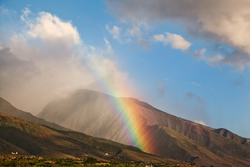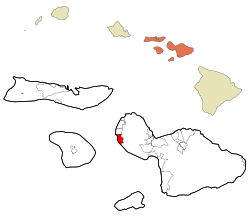Lahaina
| Lahaina, Hawaii | |
|---|---|
| Census-designated place | |

Scenic Lāhainā oceanfront
|
|
 Location in Maui County and the state of Hawaii |
|
| Coordinates: 20°53′10″N 156°40′29″W / 20.88611°N 156.67472°WCoordinates: 20°53′10″N 156°40′29″W / 20.88611°N 156.67472°W | |
| Country | United States |
| State | Hawaii |
| County | Maui |
| Area | |
| • Total | 9.3 sq mi (24.1 km2) |
| • Land | 7.8 sq mi (20.2 km2) |
| • Water | 1.5 sq mi (3.9 km2) |
| Elevation | 3 ft (1 m) |
| Population (2010) | |
| • Total | 11,704 |
| • Density | 1,300/sq mi (490/km2) |
| Time zone | Hawaii-Aleutian (UTC-10) |
| ZIP codes | 96761, 96767 |
| Area code(s) | 808 |
| FIPS code | 15-42950 |
| GNIS feature ID | 0361678 |
Lāhainā is the largest census-designated place (CDP) in West Maui, Maui County, Hawaii, United States, and the gateway to the Ka'anapali and Kapalua beach resorts to its north. As of the 2010 census, the CDP had a resident population of 11,704. Lahaina encompasses the coast along Hawaii Route 30 from a tunnel at the south end, through Olawalu, and to the CDP of Napili-Honokowai to the north. During the tourist season, the population can swell to nearly 40,000 people.
There are many different climates in the different districts of Lahaina. The historic district is the driest and calmest and hosts the small boat harbor. Kaanapali is north of a wind line and has double the annual rainfall and frequent breezes. The Kapalua and Napili areas have almost four times the annual rainfall compared to the historic district of Lahaina. The historic district has preserved 60 historic sites within a small area and they are managed by the Lahaina Restoration.
Lahaina was the capital of the Kingdom of Hawaii from 1820 to 1845, when the capital was moved back to Honolulu. In the 19th century, Lahaina was the center of the global whaling industry, with many sailing ships anchoring at its waterfront; today pleasure craft make their home there. Lahaina's Front Street has been ranked one of the "Top Ten Greatest Streets" by the American Planning Association.
Lahaina's popularity as a tropical getaway has made its real estate some of the most expensive in Hawaii; many luxury homes and condos are sold for more than $2 million there.
In antiquity Lahaina was the royal capital of Maui Loa, aliʻi nui of the island of Maui, after he ceded the royal seat of Hana to the ruler of Hawaii Island. In Lahaina, the focus of activity is along Front Street, which dates back to the 1820s. It is lined with stores and restaurants and often packed with tourists. Banyan Tree Square features an exceptionally large banyan tree (Ficus benghalensis) planted by William Owen Smith on April 24, 1873, to commemorate the 50th anniversary of the arrival of Christian missionaries. It is also the site of the reconstructed ruins of Lahaina Fort, originally built in 1832.
...
Wikipedia
